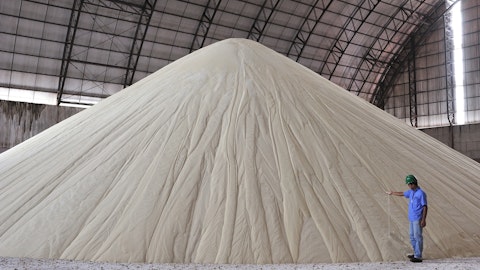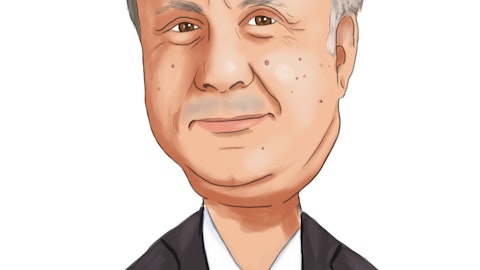And like I said, for the first quarter here, we’re at $335 to $345 per tonne on an average realized basis with China in that $280 to $300. So we’re very happy with the pricing that is happening in the market, which is reflective of tight market conditions.
Hassan Ahmed: Fair enough. Fair enough. And just moving on to the natural gas side of things, particularly in the U.S. I mean, I know between sort of last year and this year, we’ve obviously seen natural gas prices in the U.S. coming down a fair bit. Can you talk a bit about the differences in your hedging strategy between 2023 and 2024? Because I know you guys had obviously hedged out a fair amount of U.S. natural gas last year. Where does that stand this year?
Rich Sumner: Yeah, we are – so our strategy is kind of to have 3 to 5 year rolling hedges and we actually go beyond that, but at much lower quantities. And we target in the near-term years to have about 70% of our position in North America hedge. And that’s where we’re at today with G3 operating at full rates. So, effectively, you could say we’re participating, it will be participating in the spot market at around 30%. We set that level based on the minimum operating rates in our plant and we target a delivered cash cost that we’re comfortable with to operate at all points in the methanol price cycle. And so, we’ve been successful in putting in those hedges. We’re happy with where we are. We’re not seeking, in the short-term, to be hedging up beyond that level. And we continue to be active in the market layering hedges in the outer years as the new year’s roll in. So hopefully that helps you with that question.
Operator: Your next question is from the line of Ben Isaacson with Scotiabank. Your line is open.
Ben Isaacson: Thank you very much, and good morning. First question is on New Zealand. Just looking back at my model, I see, in 2016 you produced or sold 2.2 million tonnes from that region, and now 8 years later were down about 50% to 1 to 1.1. What should we be modeling as a run rate for New Zealand going forward? Not in 2024 but beyond 2024. What’s the realistic game plan there and is there an opportunity to monetize an asset that’s not being used right now?
Rich Sumner: So thanks, Ben. For modeling purposes we’re giving guidance right now at 1-year out and a lot of this is based off of developments that are happening in the natural gas fields and the Taranaki Basin as well as other factors. I think what we’ve seen, when you look at the decline over that time period that you referenced, it’s all about what’s happening in the different fields in New Zealand. We did see that there was a revision in reserve estimates in one of the major fields that brought, that was quite some time ago that brought production down. Today, I wouldn’t – we don’t forecast to have Waitara Valley, the smaller plant in our plants. We’re really focused on the two Motunui plants and getting gas for those plants.
I think when you look longer-term, how do you think longer-term for these assets is, you have to look at both above-ground and below-ground factors. And what I mean by that, above-ground, we play a huge role in New Zealand and the natural gas market. The country uses most of the power is renewable power, but natural gas is an important power source when there’s intermittent gas – intermittent power supply. And it’s a low-emission power source, otherwise you’re dependent on imported coal. We represent 50% of the market and we’re the base load customer for the natural gas industry. So I think that is an important factor. And the second one is the government. There’s just been a new government put in place in New Zealand, the center-right coalition.
Their platform is much more favorable towards the gas industry in comparison to what we’ve seen for the last 6 years. And that is a clear direction that they’ve set coming into power. So that’s positive. And then, obviously, looking at below-ground, some of the campaigns that have been run for the last year or so, they haven’t delivered the results, which is what you kind of expect, sometimes you’re going to have results, sometimes you won’t. These have not delivered results in the wells that have been producing, we’ve seen declines happening a little quicker. So we’re working with our gas suppliers really closely on the investments they’re going to be making to improve the existing wells and also the impact that has on their future campaign.
So it’s difficult to give you, what is that going to result in for a long-term run rate? What I can say is our focus is on the two Motunui plants and keeping those trying to improve the production from those assets.
Ben Isaacson: That’s super helpful. And then just one more, if I may, forgive my bad math here. But you said that the world grew at an annualized rate of 3% in Q4 and ex-China, the world was stable or maybe about roughly flat. So given that China’s roughly half of global demand, does that mean that China really grew at 5%, 6% in Q4? And if you take MTO out, what did non-MTO China do? I think that’s what investors are quite interested in, because MTO will fluctuate all the time, but we really want to see demand improvements from underlying China. Thank you.
Rich Sumner: Ben, yeah, so we did see some demand improvement in traditional applications in China, as well as MTO, and overall growth rates were about 6% in China quarter-over-quarter. Traditional applications, obviously, it is something that we’re watching really closely as well. For the year in China, we saw about 5% to 10% growth rates in China across all applications. So that was MTO, other energy applications and traditional chemical applications; and traditional chemical applications were supported in industrial production in China increased by over 5% for the year. Export demand was weak, but they were exporting a meaningful amount especially in comparison to the previous year where they were in a COVID year. So in a way what we did, we were coming off of a lower base coming into 2023, but 5% to 10% growth rates across all those different applications when it represents 60 to 65% of your demand obviously is going to be meaningful for the industry.
Operator: Your next question is from the line of Josh Spector with UBS. Your line is open.
Joshua Spector: Yeah. Hi. Thanks for taking my questions. First, I just wanted to ask just within Europe and thinking about Red Sea and Middle East disruptions. Has that had any impact on the region? I know for some other commodities talking about potentially limiting supply into Europe being an upward price perhaps catalyst. I know methanol floats tend to be in the other direction, but what are you seeing and what do you think plays out here near-term there?
Rich Sumner: That’s exactly right. It hasn’t been a big impact for us nor for the methanol industry broadly. Our supply chain we don’t have any product flowing through the Suez and the Red Sea. We would if we were supplying Egypt to Asia, but Egypt is really an asset that supplies mostly our Mediterranean customers. So we’re not impacting then as a broad industry, the flows from the Middle East have really pulled back over time and are almost negligible and that’s on the basis that there’s been a lot of new Atlantic production that’s come online over the past many years, and so it hasn’t impacted the methanol pricing are really tightened up the market in Europe. I would say what we’re continuing to monitor, which everyone will be monitoring is potential escalation in the region and the Strait of Hormuz is, where probably 15% to 20% of supply, because all Middle East supply flows through that region.
And just given recent events with Iran, something we’re watching very closely, but that would impact many, many different commodities. And so, we’ll continue to monitor that. But so far, the impact’s been pretty muted.
Joshua Spector: Thanks. I appreciate that. And just a quick one on CapEx, if I could, just as G3 winds down, I mean, you go more to maintenance levels, but you’re talking about a little bit of growth when you think about marine fuel and some other applications. What’s the range of CapEx you see over the next couple of years that will go forward?
Rich Sumner: When we look out, we don’t see any real meaningful capital in the next few years when it comes to either intrinsic organic growth opportunities or low-carbon methanol investments. It will take time to develop. We’re developing these opportunities, but that will take time. So we’re not standing still. We’re developing these. But in terms of capital spend, we don’t see a lot of outflows or outlays being needed in the next few years. So really when we look at free cash flow generation, the focus again is the balance sheet and then excess cash to shareholders, which we’ve been pretty consistent with over the years.



